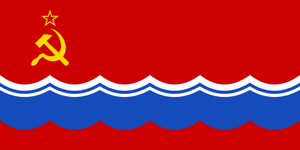Estonian Soviet Socialist Republic: Difference between revisions
(grammatical fix) |
RedParabola (talk | contribs) m (Removed references to "short twentieth century" and replaced "Bolsheviki" with Bolsheviks) |
||
| (One intermediate revision by one other user not shown) | |||
| Line 1: | Line 1: | ||
The '''Estonian Soviet Socialist Republic''' (abbreviated '''ESSR''') was a [[union republic]] of the [[Soviet Union]] from | [[File:Estonian Soviet Republic Flag.png|thumb|Flag of the Estonian ESSR (1953–1990)]] | ||
The '''Estonian Soviet Socialist Republic''' (abbreviated '''ESSR''') was a [[union republic]] of the [[Soviet Union]] from 1940 to 1991. It was succeeded by the modern state of [[Estonia]]. | |||
==History== | ==History== | ||
Estonia had briefly formed a pro-Bolshevik republic during the [[Russian Civil War]],<ref>http://www.shunpiking.org/books/GC/GC-AK-MS-chapter06.htm</ref> and the [[ | Estonia had briefly formed a pro-Bolshevik republic during the [[Russian Civil War]],<ref>http://www.shunpiking.org/books/GC/GC-AK-MS-chapter06.htm</ref> and the [[Bolsheviks]] were popular among the lower classes during the 1910s. For example, Baron Wrangel, the official historian of the Estonian German-Balt unit, recorded that during the Russian Civil War, 60–70% of Tallinn's population supported the Bolsheviks. Their popularity decreased almost entirely due to the decades of anti-socialist indoctrination<ref>https://www.revolutionarydemocracy.org/archive/BalticRepublics.pdf</ref> During the Soviet era Jerome Davis visited the [[Baltic states|Baltics]] and found that most, if not all of the workers and peasants there preferred being part of the Union of Soviet Socialist Republics<ref>https://books.google.com/books?id=YD8-kLoofw4C&q=all+in+favor</ref> (whereas the middle and upper classes{{Clarify}} freely voiced their objections to him), and everybody that he met, even the upper classes, still preferred the Soviet Republics over the anticommunist reoccupation.<ref>https://books.google.com/books?id=YD8-kLoofw4C&q=preferred</ref> Nevertheless, a gang of [[antisocialist|anti-socialist]] [[guerrillas]] known as the [[Forest Brothers]] fought against the Soviets from 1940 to 1956. They caused 18,562 fatalities throughout the Baltics.<ref>https://books.google.com/books?id=8urEDgAAQBAJ&pg=PA538</ref><ref>https://books.google.com/books?id=Ad3-xvwdjE4C&pg=PA155</ref> The Estonian SSR also had the second-highest anti-Russian sentiment out of all of the other Soviet republics, but anti-socialism itself was rare.<ref>https://archive.org/stream/HumanRightsInTheSovietUnion#page/n47/mode/1up</ref> | ||
==Culture== | ==Culture== | ||
| Line 9: | Line 10: | ||
==References== | ==References== | ||
{{Reflist}} | {{Reflist}} | ||
[[Category:Republics of the USSR]] | [[Category:Republics of the USSR]] | ||
[[Category:History of Estonia]] | |||
Latest revision as of 16:16, 15 June 2024
The Estonian Soviet Socialist Republic (abbreviated ESSR) was a union republic of the Soviet Union from 1940 to 1991. It was succeeded by the modern state of Estonia.
History
Estonia had briefly formed a pro-Bolshevik republic during the Russian Civil War,[1] and the Bolsheviks were popular among the lower classes during the 1910s. For example, Baron Wrangel, the official historian of the Estonian German-Balt unit, recorded that during the Russian Civil War, 60–70% of Tallinn's population supported the Bolsheviks. Their popularity decreased almost entirely due to the decades of anti-socialist indoctrination[2] During the Soviet era Jerome Davis visited the Baltics and found that most, if not all of the workers and peasants there preferred being part of the Union of Soviet Socialist Republics[3] (whereas the middle and upper classes[clarification needed] freely voiced their objections to him), and everybody that he met, even the upper classes, still preferred the Soviet Republics over the anticommunist reoccupation.[4] Nevertheless, a gang of anti-socialist guerrillas known as the Forest Brothers fought against the Soviets from 1940 to 1956. They caused 18,562 fatalities throughout the Baltics.[5][6] The Estonian SSR also had the second-highest anti-Russian sentiment out of all of the other Soviet republics, but anti-socialism itself was rare.[7]
Culture
In the 1970s the percentage of books published in the titular language was 74%, and of newspapers 72%.[8]
References
- ↑ http://www.shunpiking.org/books/GC/GC-AK-MS-chapter06.htm
- ↑ https://www.revolutionarydemocracy.org/archive/BalticRepublics.pdf
- ↑ https://books.google.com/books?id=YD8-kLoofw4C&q=all+in+favor
- ↑ https://books.google.com/books?id=YD8-kLoofw4C&q=preferred
- ↑ https://books.google.com/books?id=8urEDgAAQBAJ&pg=PA538
- ↑ https://books.google.com/books?id=Ad3-xvwdjE4C&pg=PA155
- ↑ https://archive.org/stream/HumanRightsInTheSovietUnion#page/n47/mode/1up
- ↑ https://archive.org/stream/HumanRightsInTheSovietUnion#page/n45/mode/1up
